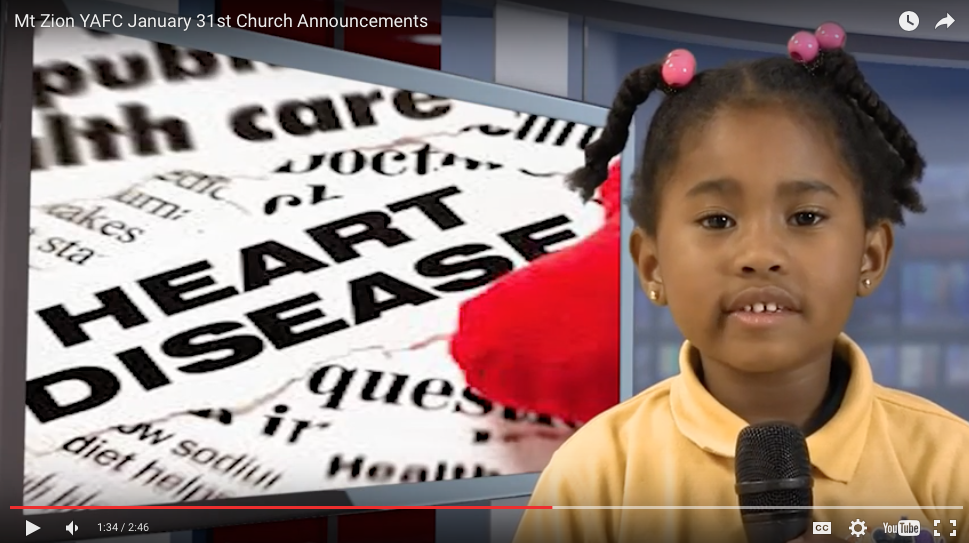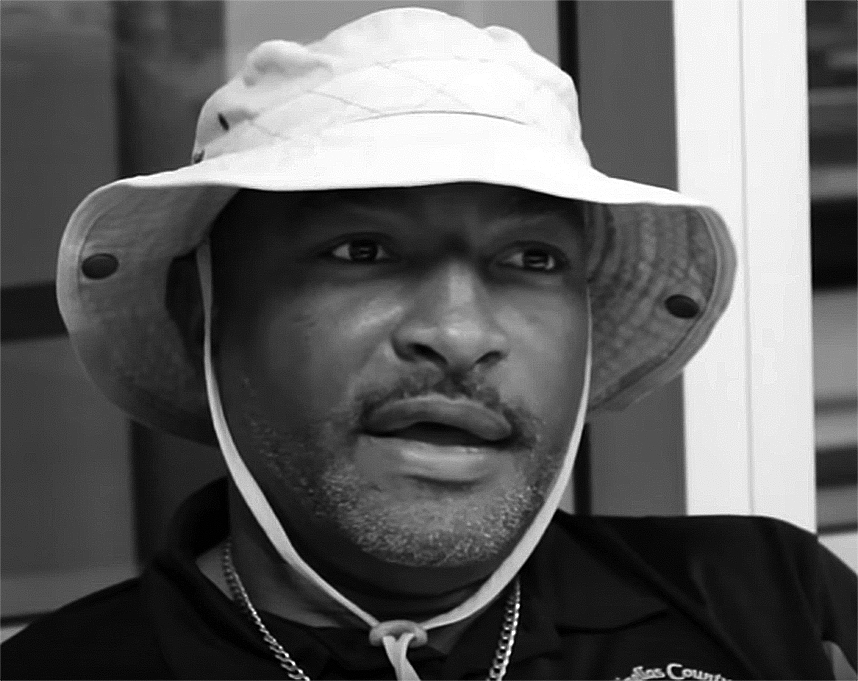Category: MIDTOWN NEWS
Parent category for all other news categories.
-
Dr. Martin Luther King, Jr. Day of Service Project: ‘King’s Dream Unite’
BY LAURA MULROONEY
NNB ReporterST. PETERSBURG — As part of the nationwide Martin Luther King, Jr. Day of Service, a substantial crowd gathered as a mural by local artist Ya La’ford was unveiled on the north side of the historic Manhattan Casino in Midtown Monday.
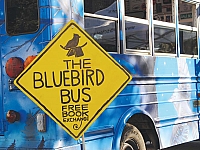
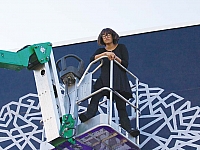
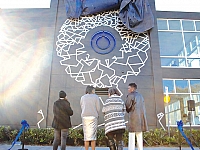
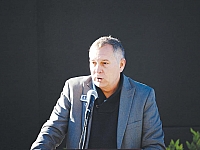
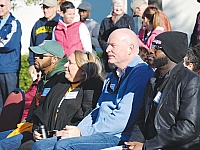
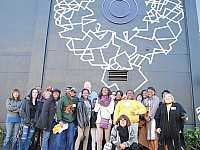
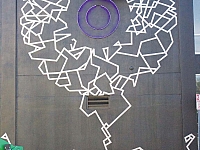
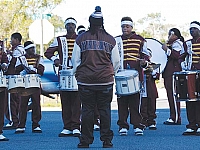
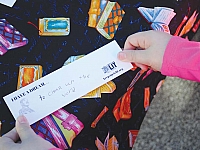
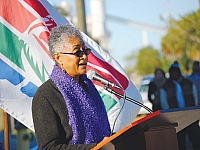
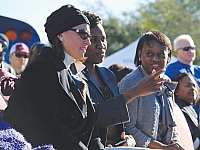
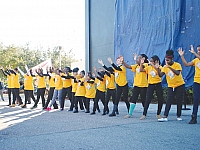
Titled “King’s Dream Unite,” La’ford and 25 students from MYcroSchool Pinellas, a tuition-free, dropout recovery, public charter high school, painted the expansive 30’x30’ mural in one week with what was described as a “tremendous amount of paint.”
“King’s Dream Unite” is a community mural where La’ford admits the community helped her realize Martin Luther King Jr.’s dream.
“The mural is about unity, this is about how we’re connected, this is about how we can pull and collaborate the community together where I am not only exposing you to the visual but also to the dance and to the music, I am kind of forging these forces together to have something so impactful to the community,” she said.
The event Monday began with the roar of the Mt. Zion Progressive Community Marching Band. The 13-percussion piece ensemble’s force and presence brought the crowd alive with the beat of their drums and crash of their cymbals.
“The pounding of the drums represents our heartbeats coming together,” said La’ford at the end of the event.
Jacqueline Williams Hubbard, Esq./Pres., St. Pete Chapter, The Association for the Study of African American Life and History spoke of the importance of the mural’s location on the side of the historic Manhattan Casino. For 40 years the Manhattan Casino played an instrumental role in south St. Petersburg arts, entertainment, and cultural development in the 1920s when Jim Crow segregation laws were still prevalent.
The Moving Mural, a collaborative dance and song presentation performed by dancer and rehearsal director Helen Hansen French, singer Becca McCoy, MYcroSchool students and Mt. Zion Impact Dance Ministry confirmed that arts and entertainment still thrive in Midtown.
La’ford along with Deputy Mayor Dr. Kanika Tomalin, Councilwomen Lisa Wheeler-Brown and Darden Rice and Chris Steinocher, president and CEO St. Petersburg Area Chamber of Commerce cut the ribbon as the tarp simultaneously raised, revealing the unified efforts of a diverse community.
The mural consists of a black background with silver intersecting geometrical lines starting from the base of the building like tree roots that grow upwards to form the trunk and then a circular crown. The crown embraces two illuminated circles, one inside the other. A description by La’ford is essential to understand the magnitude of the piece.
“Black represents the color of our people, the lines forge together in silver, silver being one of the oldest and most precious metals, as precious as our people. The three circles represent all of us rotating around each other for infinity. The geometric patterns represent how all of our lives intersect, everyone’s life journey may have traversed to the left or to the right but they will all intersect at some point. The center two circles are illuminated to acknowledge the presence of a higher being connecting us all together.”
La’ford consistently involves children in her art to show that art is in everything that they do and see. This project provided MYcroSchool Pinellas students with the opportunity to participate in something they would not have normally done.
The mural unveiling also included a free book giveaway for students and children courtesy of Keep St. Pete Lit and Bluebird Books. Students received bookmarks where they could write their response finishing MLK Jr.’s famous sentence “I have a dream.”
Laura Mulrooney is a reporter in the Neighborhood News Bureau at the University of South Florida St. Petersburg.
-
Kriseman addresses gun violence, Midtown neighborhood problems in ‘State of City’ speech
BY SAMANTHA PUTTERMAN FOR THE CROW’S NEST:
Mayor Rick Kriseman addressed issues of gun violence that claimed the lives of seven people and Midtown problems including the education gap and high unemployment during his annual State of the City speech Saturday, Jan. 23.
“We are addressing the risk factors that affect our children and young adults,” Kriseman told The Crow’s Nest. “We are determined to do what we can to end gun violence and, most importantly, the underlying choices that lead to violence.”
Kriseman also said more action and solutions are needed to help struggling schools, labeled “Failure Factories” in a series of stories by The Tampa Bay Times. He also noted the need for increasing job recruitment, entrepreneurship and business retention in Midtown.
READ THE FULL STORY ON THE CROW’S NEST.
-
A History in Photographs: Jordan Park
It’s 1939. You and your entire family lives in what is essentially a shack with three other families. The roof leaks. There’s cracks in the walls, loose floorboards. You have to walk out the front door and around the back to use the toilet. There’s no electricity. There’s no running water. There’s nowhere else to go.
The public housing subdivision called Jordan Park, located in Midtown St. Petersburg, has a rich history of highs and lows. It was originally developed as an African American community during segregation. Although nowadays it’s considered quite a low-key, peaceful place, Jordan Park residents throughout time have gone from the poorest living conditions to living in state-of-the-art homes to then living in an area filled with drugs and crime. Despite everything, a strong sense of community in Jordan Park has always prevailed.
https://www.youtube.com/watch?v=TAj-oS4Ys0A
Records show that African Americans have always lived in the south side of St. Petersburg, ever since groups first came to the area in the late 19th century during the Florida land boom. However as time went on, African Americans were pushed more and more south of Central Ave. They lived in the areas of St. Petersburg known as the Gas Plant District, Methodist Town and Pepper Town. Today, this is essentially where the interstate and Tropicana Field are located.
Even when Jordan Park was built, people still resided in the old communities of the Gas Plant District, Methodist Town and Pepper Town up until the interstate and the Trop were built over them.
According to James Schnur, head of Special Collections and University Archives at USF St. Petersburg, living conditions in these communities were “almost intolerable by the 1930s.”
Pictures from a scrapbook constructed in the 30s, now belonging to the USFSP Special Collections, show old, dingy wooden houses with broken balconies, no indoor plumbing, no ventilation, leaky roofs, cracks in the walls, no electricity and broken floorboards.
Oftentimes there would even be multiple families living in the same home.
Segregation was very strong in St. Petersburg during this time period. Whites tended to ignore black communities for the most part and were not allowed in many areas of St. Pete, including Downtown, with the exception of working.
When the issue of housing for African Americans was brought for debate, a number of white folks sided for the city to provide better housing, according to Schnur. Many African Americans during this time worked in service jobs and were hired by these white folks. White people were concerned about possible illnesses that could potentially be caused by such poor living conditions. They didn’t want themselves to get sick or contaminated as a result.
The project was soon given the green light. In the summer of 1939, construction began. Money for the project was given by the city of St. Petersburg and the federal government from President Franklin D. Roosevelt’s New Deal Plan during the Great Depression.
Land farther south was donated by a man named Elder Jordan, a successful business man and who owned a large amount of real-estate in Pinellas County and advocate for equality for African Americans. The stretch of land reaches from 9th Ave S down to 13th Ave S and 26th St S to 22nd St S.
A majority of the construction was completed by the summer of 1940. Over the next year, more houses were added.
The houses in the older African American communities were primarily made of wood. Schnur notes that this was not rare, even in the late 1930s, but it also wasn’t the most innovative tool. The houses in Jordan Park were made from concrete blocks.
Upon the completion of construction, newspaper articles reported as many as almost 2,000 residents lived in the subdivision at one point. There was even a waitlist to get in. The houses did their job of providing a safe, sanitary place for people to live. All was well.
As the years went on, public housing began to earn a bad stigma. Crime and drugs started to appear on headlines in connection with Jordan Park. Shootings became frequent. Children witnessed drug deals. The city hired extra police officers to canvas the area at night because it was so bad, according to the Times. However, the extra police officers in the neighborhood ended up having a positive effect and decreasing crime rates during this time by more than 80%.
Eventually time and use began to wear the houses of Jordan Park away. In the late 90s, the St. Petersburg Times, now Tampa Bay Times reported complaints of broken streetlights and the old military-style buildings looking ragged.
There was a lot of controversy about demolishing Jordan Park and replacing it with new houses. Many residents argued in newspaper interviews that it would be taking away from its legacy. At this point it was the oldest public housing project in St. Petersburg.
Demolition began in late 1999. It was once again funded by the city and the federal government, this time with help from Hope VI. The St. Petersburg Times reported $27 million was put into the project. The project was completed in 2001.
Many residents who lived in Jordan Park during that time moved elsewhere. The residents who moved out were given an allowance to move elsewhere if they chose to do so. About 50 families opted to stay and lived in the subdivision while construction went on.
The subdivision went from hosting 446 homes to 236 houses, apartments, duplexes and triplexes. Hundreds of people once again put their names on the list to live in the vibrant-colored houses of Jordan Park.
Jordan Park went through a number of ups and downs throughout the years. It stood its ground throughout the times of the thriving deuces to the political riots of Midtown. Nevertheless, a strong sense of community has always survived through its residents. Even though it had to be knocked down and rebuild, its legacy still stands. The community still stands.
-
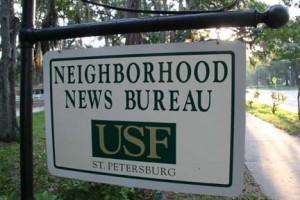
It’s not a class. It is a newsroom.
BY ZENENA MOGUEL
NNB REPORTER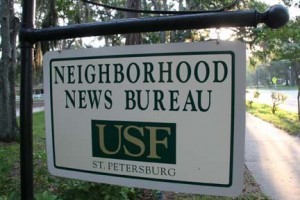
Sign of Neighborhood News Bureau located in Midtown. Photo courtesy of nnbnews.com. ST. PETERSBURG – At University of South Florida St. Petersburg’s (USFSP) Department of Journalism & Media Studies exists a class that prepares students for the path of professional journalism. Unless you’re a part of this department, you probably have not heard of Neighborhood News Bureau (NNB). To many it’s just another required course, but it carries a different meaning to those who have taken it. To those ‘it is a newsroom.’
“Neighborhood News Bureau is a mix. It’s not just a class,” said Dr. Bernardo Motta. “They actually work like they were working in a newsroom. They do their assignments just like they would do in a newsroom for publication.”
Founded by George Killenberg and late Robert Dardenne, NNB originated in 2001, but officially opened its offices in March 2006 in the community it continues to serve – Midtown, St. Petersburg. Just south of Downtown St. Petersburg, Midtown was once the heart of the black community. Though trying to get revitalized, the media as well as the government have always overlooked the community. NNB strives to serve this community and uncover the stories that still need to be discovered.
“Midtown is everything for NNB. Without Midtown, we don’t have NNB,” said Motta. “The stories we tell are stories that aren’t usually told in mainstream media. There’re so many stories that are missing and nobody is telling those stories. That’s what NNB does,” Motta continued. “We’re basically filling that gap.”
Indhira Acosta Suero, NNB reporter. Click on the picture to read her story[sg_popup id=”2″] 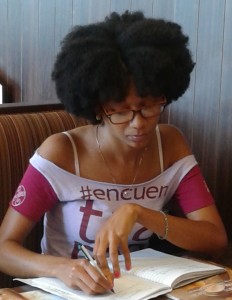 [/sg_popup]
[/sg_popup]
Lorien Mattiacci, NNB reporter. Click on the picture to read her story.
[sg_popup id=”4″]
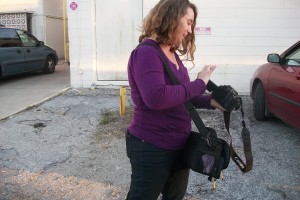 [/sg_popup]
[/sg_popup]Eric Vaughan, NNB reporter. Click on the picture to read his story. [sg_popup id=”3″]
 [/sg_popup]
[/sg_popup]Danielle Von Dreele, NNB reporter. Click on the picture to read her story
[sg_popup id=”1″]
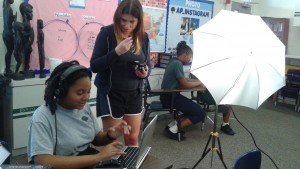 [/sg_popup]
[/sg_popup]Undergraduate student Danielle Von Dreele and graduate students Indhira Suero Acosta, Eric Vaughan, and Lorien Mattiacci shared their experiences in NNB and believes NNB has prepared them for their future in journalism.
NNB is completely staffed by both undergraduate and graduate students and the faculty of the department. The newsroom aims to provide real-life experiences to young journalists and reporters while challenging the students to step out of their comfort zones.
“They have to pitch their stories. They have to come up with their own ideas and produce the stories for different types of media,” said Motta. “Jared [NNB’s Graduate Assistant] and I basically work more as the editors.”
Apart from getting out into the real world, these students get to hear from media professionals in the field. A number of award-winning media professionals shared experiences and knowledge with NNB students during the semester. The list includes Lara Cerri (photojournalist at the Tampa Bay Times), Michael LaForgia (investigative journalist at the Tampa Bay Times), Adam Playford (director of data and enterprise at the Tampa Bay Times), Mary Shedden (news director at WUSF), Craig Pittman (environmental journalist at the Tampa Bay Times) and Cynthia Barnett (environmental journalist and book author), and Kate Bradshaw (news and politics editor at the Creative Loafing Tampa).
After all, NNB is also building relationships with the mainstream publications like Creative Loafing and The Weekly Challenger. Multiple students have been published this semester, and for some it was their very first published work.
“I was so excited,” said graduate student, Lorien Mattiacci. “This was my first non-academic publication.”
From education, arts, events, and even the city council election of St. Petersburg, the impact NNB is having on the community is significant in building relationships with entrepreneurs, teachers, politicians, and members of the community.
Elihu Brayboy, entrepreneur and business owner, remembers the time he got involved with an article about the history of the Mercy Hospital in Midtown by a NNB student.
“The great thing that happen from it (article) was I got a phone call from a Dr. Crist, who happens to be Governor Charlie Crist father, who said he spent time at the Mercy Hospital as an intern when he first got out of med school,” said Brayboy. “He knew my mother and the doctor that was in the story and he knew a lot of other things. As a result, he was willing to meet with the student to talk more about the history of the Mercy Hospital from his perspective,” Brayboy continued. “So that is a phenomenal thing that would never have happened without the student assignment you guys are doing about the community.”
NNB students are working with many others like Brayboy who are being impacted by the stories these students are telling.
“It is very important for them (NNB students) to keep digging stories out which may seem to be redundant, but it’s not redundant, ” said Brayboy.
While NNB students are working on covering the Midtown community, the Midtown community, in turn, is having an impact in these students’ lives. Listen to NNB student, Clarence Ford, as he shared his story on how NNB has made him become a more active member of the Midtown community. Ford is also planning on joining the National Association for the Advancement of Colored People (NAACP).
One would think this is an actual newsroom, and in reality it is. Each student selects a beat of his or her own interest preparing them for their future in journalism.
-
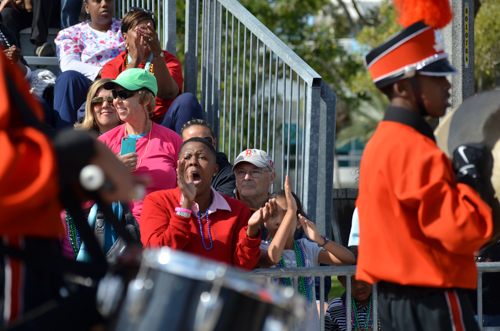
Celebration and remembrance at St. Petersburg’s MLK Parade
BY MIRANDA BORCHARDT
NNB ReporterDOWNTOWN — An estimated crowd of 3,000 people filled the streets of downtown St. Petersburg to take in the 31st annual Drum Major for Justice National Parade celebrating the life of Martin Luther King Jr. Monday, Jan. 18.
This St. Petersburg tradition is the nation’s longest running Martin Luther King Jr. Day parade with the inaugural event being held on Jan. 20, 1986.
Student Matthew Vorra, 15, and friends spent their school day off traveling from Seffner to experience the event but mostly to celebrate, remember and honor the legacy of the civil rights leader.
King was “a man who fought for what he believed in,” said Vorra.
The parade showcased local school marching bands, dance troupes and floats featuring community groups and local businesses who embraced the spectators with smiles, waves and by throwing beads to the crowd. There were even a few local celebrities who joined the two mile route from Tropicana field down to Vinoy Park including Mayor Rick Kriseman and former Florida Gov. Charlie Crist.
Yolanda Fernandez, St. Petersburg police spokeswoman, said attendance was average. Some attendees may have been deterred by the lower than normal temperatures for the day.
While the crowd was all smiles some were pensive remembering the times of struggle while embracing their freedoms of today. Charles Payne, 80, of St. Petersburg, has attended for about 20 years.
“Martin Luther King (Jr.) stood for nonviolence,” he said. “It is good to see so many people recognize (that).”
-
‘Champions of Peace’ honored in MLK high school essay contest
BY LAURA MULROONEY

Tasina Taylor 1st Place
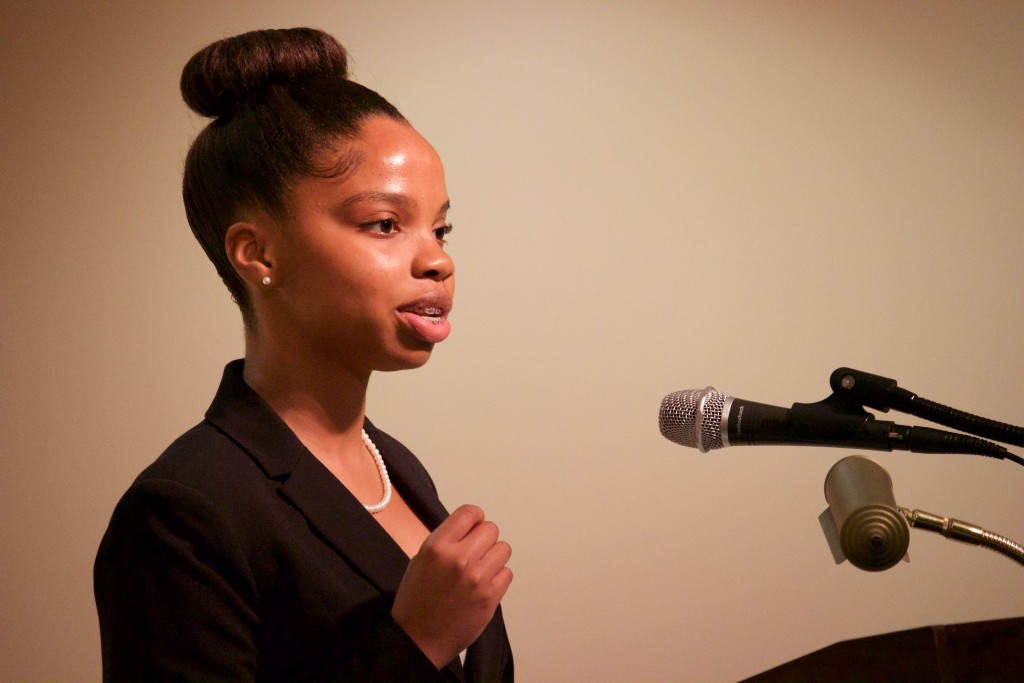
Alexandra Givins 2nd Place
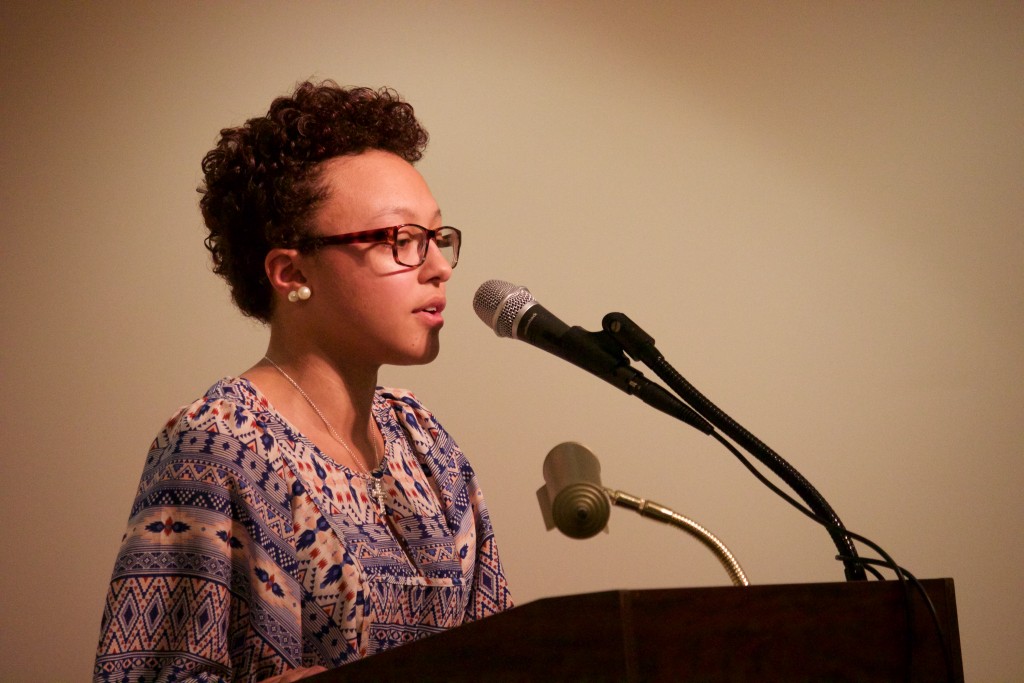
Amber Seay 3rd Place
The excitement is amplified by the rhythmic beats overhead from African Tribal Orchestra’s album “Sounds Like Africa.” The stage is empty, save for an oversized portrait of Dr. Martin Luther King, Jr. awaiting the start of the contest with an inquisitive yet solemn gaze.
As the contest commences the support can be felt through the words and emotions displayed on stage during opening remarks by Virginia Scott and Jarish Jones, Master of Ceremonies.
For the first time since the contest’s inauguration, all six contestants were African American females; a proud accomplishment acknowledged by Virginia Scott, EDC Senior Advisory Council and Leontyne Middleton, both members of the SPC of MLK, Jr. CO, Inc.
Diversity among the contestants is always welcomed and has been the norm throughout the existence of the contest, but with this year’s finalists being all female it has shown the community that women are no longer supporters in the background but front running leaders.
The prompt for this year’s contest was to identify a ‘Champion of Peace’ and why? After experiencing an increase in violent protests, mass shootings, and terrorist attacks around the world over the last few years, the words of these future leaders lingered heavily amongst the more than 45 attendees.
As stated by Leontyne Middleton in her closing remarks these powerful, young women “spoke about our world today – multinational.” The champions mentioned in the student’s essays spanned the globe from Pakistan, Kenya, Liberia, and the United States.
Contest winner and Lakewood High School Senior Tasina Taylor’s tenacious presentation defined a champion as “a person or figure that fights, argues, and defends greatly for a cause on the behalf of something or someone.” Her champion of peace is President Barack Obama.
With over 50 top accomplishments Taylor believes the defining act that made President Obama the ultimate champion of peace was when he “ordered Special Forces to raid a secret compound in Abbottabad, Pakistan to assassinate the calamitous leader Osama Bin Laden” bringing America great peace, a justice former president George W. Bush could not serve.
Taylor won a $200 cash prize and a seat at the VIP table for her and an accompanying adult at the 30th Annual MLK Leadership Award breakfast being held at the Coliseum Mon., Jan 18. Taylor and her guest will enjoy breakfast with members of Dr. Martin Luther King Jr.’s family.
First runner up Alexandra Givins, a junior at Gibbs High School gave an emotional speech on Malala Yousafzaoi, a young woman in Pakistan who survived an assassination attempt by the Taliban for bringing education to young females in a country where women are forbidden to learn. Yousafzaoi won Pakistan’s first National Youth Peace Prize for her efforts. Alexandra won a $100 cash prize.
Leymah Gbowee was third place winner Amber Seay’s champion. Gbowee is a Liberian peace activist known for stepping up to protect the lives of women and children in a civil war ridden country. Amber attends Lakewood High School and won a $75 cash prize.
Fourth place winner Tatjana Simmons from Lakewood High School chose Tegla Loroupe, a Kenyan long distance and roadrunner who was the first African American female to win the New York City Marathon. Tegla is a spokeswoman for a peaceful coexistence across the globe.
Fifth place winner Brittany Matthews spoke of Dr. Martin Luther King, Jr. and his accomplishments that advanced the civil rights movement in the United States.
Finalist Deonnie J. Brown was unable to attend.

Jacquilin Wallace, Shelia Lamb, and Arcilous Mincey
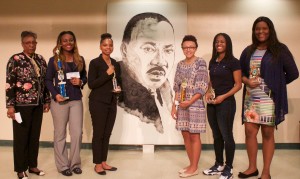
Virginia Scott poses with finalists
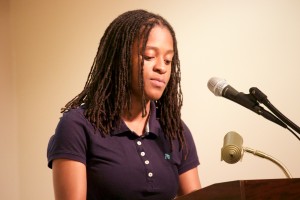
Tatjana Simmons 4th Place
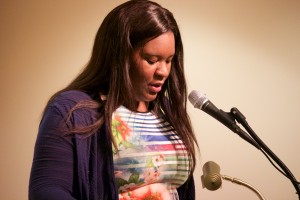
Brittany Matthews 5th Place
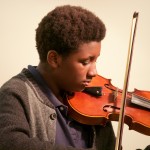
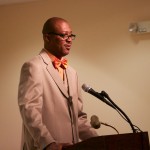
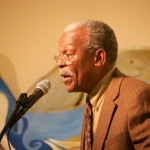
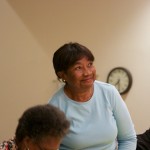
Carlos Walker, Jr. an 8th Grader at John Hopkins Middle played Lift Every Voice on the violin. GLP Inspirational Dance Team provided the entertainment while the judges discretely tallied their scores.
Jacquilin Wallace, Shelia Lamb, and Arcilous Mincey, all educators, took on the challenging role as judges. Jarrish Jones, from St. Petersburg Youth Build, maintained his role as Master of Ceremonies for the 7th year. Charlie Williams, of Alpha Phi Alpha Fraternity, Inc., and Virginia Scott of SPC of MLK, Jr. CO, Inc. presented the awards to the finalists.
This event was sponsored by the St. Petersburg Chapter of the Dr. Martin Luther King, Jr. Commemorative Organization, Inc. Committee (SPC of MLK, Jr. CO, Inc), in cooperation with the Theta Eta Lambda Education Foundation of Alpha Phi Alpha Fraternity, Inc.,
Laura Mulrooney is a reporter in the Neighborhood News Bureau at the University of South Florida St. Petersburg.

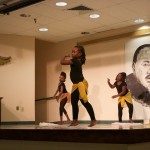
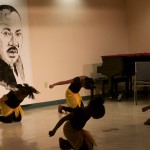
GLP Inspirational Dance Team
-

A Walk Through Midtown
BY CARLY ROMANO
NNB REPORTERUse this map as your guide to take a walk through historic Midtown of St. Petersburg.
The marked destinations highlight thriving places, attractions, and restaurants within the progressing area.
Click on each hot spot for pictures and information, including addresses!
Note: Zoom in for larger view.
